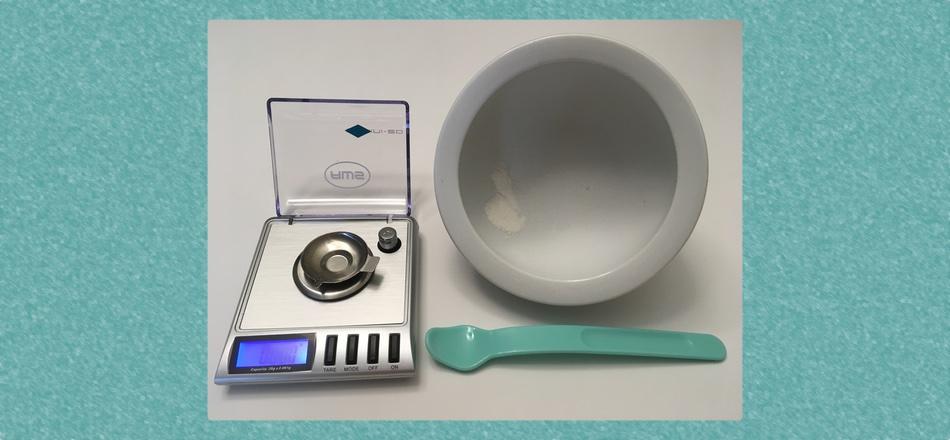Using a Digital Scale to Weigh Powder from a Crushed Immediate-release Tablet or Poured-out Powder or Beads from a Capsule

1. Get informed about possible safety-related issues.
Crushing an immediate-release tablet or opening a capsule and exposing the contents to light or air can potentially change the chemical properties of a drug, which in turn can create safety risks. Consult a well-informed pharmacist about how to safely store the contents of a crushed tablet or poured-out capsule. There may also be information in the drug label about proper storage under different conditions.
2. Get informed about possible accuracy issues with measuring on a digital scale, and consider solutions.
Lower-cost digital scales are usually not able to display readings of weights that are less than 0.001g or 1mg. In practical terms, due to normal error rates and how these digital scales round up and round down, this means that the smallest cuts that can be made with reasonably reliable accuracy using such a scale are about 0.010g or 10mg. See "Understanding the Limits of a Digital Scale’s Accuracy" in Step 18 for more information.
Possible solutions include investing in a very high-end digital scale, or using a pharmaceutical-grade powder filler such as lactose to increase the overall base weight of the drug. For more information, see "Diluting Powder When Using a Digital Scale" in Step 18. However, we know of no similar solution for beads.
3. Decide how many doses to make at a particular time and how to fill empty capsules, or decide if the doses will be mixed in a liquid such as water and consumed.
Some people make one dose at a time for simplicity’s sake. Other people prefer to make a number of doses at once in order to streamline the work, as they find they “get in the rhythm” of weighing powder or beads and putting the contents into capsules. In addition, as discussed above, larger weights can help address problems in the level of accuracy of certain digital scales. They’ll then store future doses in capsules in a pill organizer or properly labeled, clean pill bottle. Others may instead mix their doses directly in a liquid such as water and consume immediately. If storing either dry powder or a liquid mixture, it is important to know how long they can be safely stored. For information on safe storage, it may be helpful to consult a knowledgeable pharmacist and refer to the “Stability Criteria and Beyond-Use Dating” section of the U.S. Pharmacopeia <795> Pharmaceutical Compounding – Nonsterile Preparations.
4. Set a schedule.
Back in Step 14, you decided whether you’d taper using a Daily Microtaper or Cut-and-hold schedule. If it’s been a while since you made that decision, you might want to go back and refresh your memory because some of the calculations you’ll do in Step 19 will depend on your chosen schedule.
5. Consult a pharmacist about storing loose beads or powder.
Many people in the lay withdrawal community who are taking beaded capsules choose to save the loose, extra beads that they’ve cut from their dose in order to use them later. Some people prefer to save loose powder, as well, for later doses. It’s essential to first check with a well-informed pharmacist about whether either of these options is safe, and if so, what the proper measures are for storing these loose contents.
In this section
- Step 10- Get Informed About Your Psychiatric Drug
- Step 11- Ensuring that a Drug is Relatively ‘Taper-friendly’
- Step 12- Interactions, Reactions and Sensitivities
- Step 13- Taper Rates
- Step 14- Taper Schedules
- Step 15- Taper Methods
-
Step 16- Preparatory Decisions
- Making a Liquid Mixture Using Immediate-release Tablets or Capsules
- Using a Digital Scale to Weigh Powder from a Crushed Immediate-release Tablet or Poured-out Powder or Beads from a Capsule
- Counting Beads from a Beaded Capsule
- Using a Compounding Pharmacy to Obtain Capsules and/or Liquid
- Using a Manufacturer’s Oral Liquid
- Step 17- Gather the Gear
- Step 18- Essential Skills
- Step 19- Setting Up a Taper Journal
- Step 20- Implementing a Taper
TWP’s Companion Guide to Psychiatric Drug Withdrawal Part 2: Taper